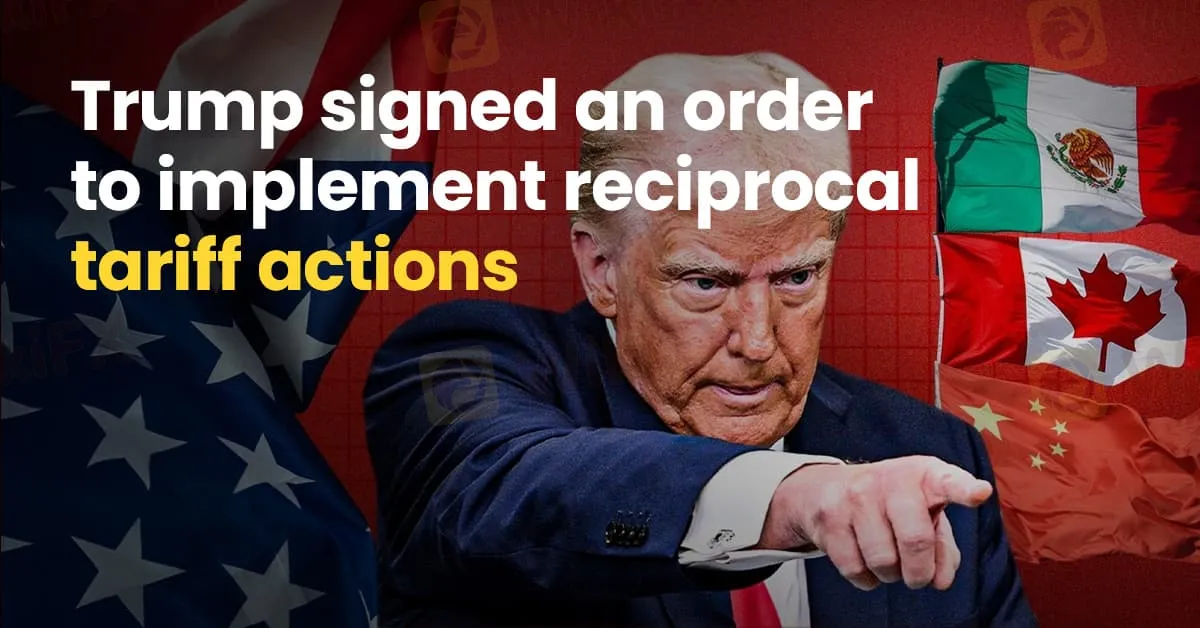简体中文
繁體中文
English
Pусский
日本語
ภาษาไทย
Tiếng Việt
Bahasa Indonesia
Español
हिन्दी
Filippiiniläinen
Français
Deutsch
Português
Türkçe
한국어
العربية
Trump signed an order to implement reciprocal tariff actions
Abstract:The directive includes calculating duties to match those other countries charge and addressing non-tariff barriers such as vehicle safety rules and value-added taxes that hinder U.S. exports.

On February 13, 2025, President Donald Trump signed a memorandum directing his economic team to develop plans for implementing reciprocal tariffs on all countries that impose tariffs on U.S. imports. This strategy aims to ensure fairness by matching the tariffs charged by other nations on American goods. The directive includes calculating duties to match those other countries charge and addressing non-tariff barriers such as vehicle safety rules and value-added taxes that hinder U.S. exports.
According to Reuters, the Key Aspects of the Reciprocal Tariff Plan include:
- Targeted Countries: The plan focuses on major trading partners, including China, Japan, South Korea, and the European Union.
- Implementation Timeline: While the memorandum initiates the development process, the new tariffs are not expected to be levied immediately. White House officials have indicated that the administration aims to move quickly, suggesting a timeline of “weeks” rather than “months” for implementation.
- Economic Implications: The announcement has raised concerns about potential economic repercussions, including fears of a global trade war and the possibility of increased consumer prices. However, Wall Street responded positively, relieved that new tariffs were not immediately implemented.
Context and Background
This move is part of President Trump's broader efforts to address trade imbalances and promote fair trade practices. The reciprocal tariff plan builds upon previous actions, such as the 25% tariffs on steel and aluminum imports and the 10% tariffs on Chinese goods. The administration's approach reflects a shift towards more protectionist trade policies, aiming to level the playing field for U.S. industries.
Potential Global Impact
The implementation of reciprocal tariffs could lead to significant changes in global trade dynamics. Countries affected by these tariffs may seek to negotiate trade agreements to reduce or eliminate the new duties. Additionally, businesses may need to adjust their supply chains and pricing strategies in response to the changing trade environment.
As the Trump administration moves forward with this plan, the global community will be closely monitoring the developments and their potential impact on international trade relations.

Disclaimer:
The views in this article only represent the author's personal views, and do not constitute investment advice on this platform. This platform does not guarantee the accuracy, completeness and timeliness of the information in the article, and will not be liable for any loss caused by the use of or reliance on the information in the article.
Read more

Never Heard of Dynasty Trade? Here's Why You Should Be Worried
Have you heard this name before? No , it’s time you do because staying unaware could cost you. This platform is currently active in the forex trading and has been linked to several suspicious activities. Even if you’ve never dealt with it directly, there’s a chance it could reach out to you through ads, calls, messages, or social media. That’s why it’s important to know the red flags in advance.

WEEKLY SCAM BROKERS LIST IS OUT! Check it now
If you missed this week's fraud brokers list and are finding it difficult to track them one by one — don’t worry! We’ve brought together all the scam brokers you need to avoid, all in one place. Check this list now to stay alert and protect yourself from fraudulent brokers.

Catch the Latest Update on BotBro & Lavish Chaudhary
BotBro, an AI-based trading platform, became popular in India in 2024—but for negative reasons. Its founder, Lavish Chaudhary, who gained a huge following by promoting it heavily on social media. Since then, he has become well-known, but for many controversies. Let’s know the latest update about Botbro & Lavish Chaudhary.

Trading Other People’s Money | What Prop Firms Don’t Tell You
Proprietary (prop) trading firms have become increasingly popular. They give traders the chance to trade with larger amounts of money without risking their own savings. For many, this sounds like the perfect opportunity to grow faster and earn more. But while the benefits are appealing, there are also risks and hidden rules that traders must understand before joining a prop firm.
WikiFX Broker
Latest News
WEEKLY SCAM BROKERS LIST IS OUT! Check it now
Apex Trader Funding is an Unregulated Firm | You Must Know the Risks
What WikiFX Found When It Looked Into Aron Markets
Textiles to whisky: U.K.–India 'historic' deal is set to boost bilateral trade by over $34 billion a year
Thailand-Cambodia border clashes: Cambodia's economy has more to lose, analysts say
Puma shares plunge 18% after full-year sales, profit outlook cut on U.S. tariffs
Is Your Forex Strategy Failing? Here’s When to Change
FSMA Warns That Some Firms Operate as Pyramid Schemes
Federal Reserve likely to hold interest rates steady despite pressure from Trump. Here's what that means for your money
Sigma-One Capital Scam? Investors Say They Can’t Withdraw Funds
Currency Calculator


